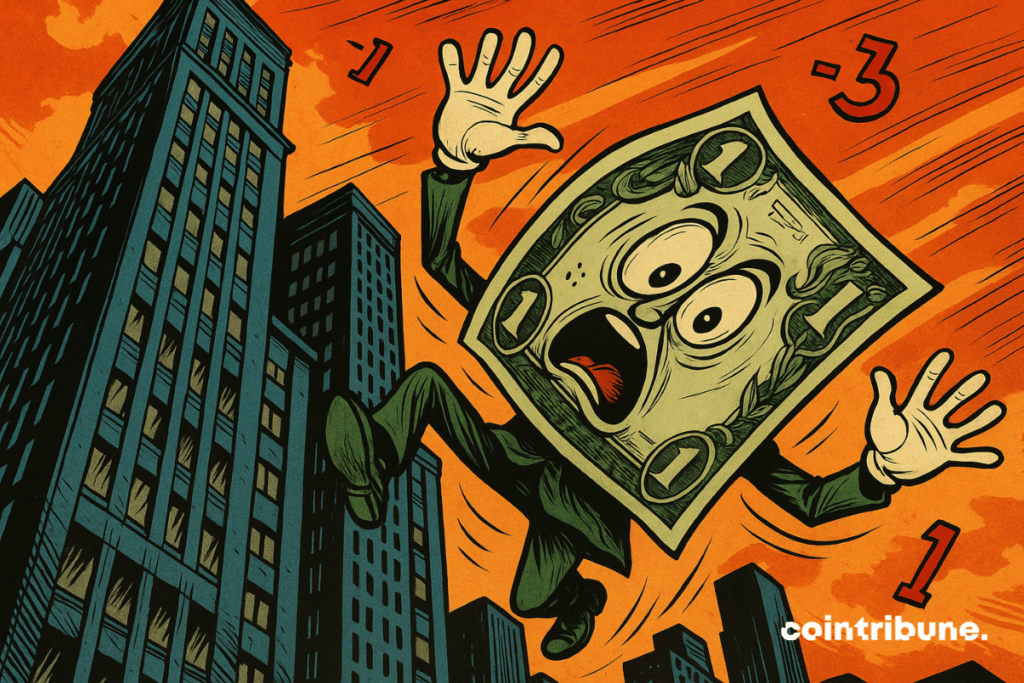Dollar Hits Three-Year Low Amid Market Turmoil
While Wall Street continues to break records, the dollar is collapsing at an unprecedented rate since 1973. This wide gap is no coincidence. It reflects a global shift fueled by geopolitical tensions, a Federal Reserve under political pressure, and macroeconomic uncertainties. Benchmarks are eroding, markets are seeking safe havens. In this silent but brutal reshuffling, cryptos are once again asserting themselves in the strategic field, driven by their decentralized logic amid the instability of state currencies.

In Brief
- June 26, 2025 marks a historic day: stock markets reach new highs while the dollar plummets sharply.
- The S&P 500, Nasdaq, and Dow Jones record spectacular gains, driven by tech, investor euphoria, and a truce between Israel and Iran.
- At the same time, the dollar hits its lowest level in three years, down more than 10% since the start of the year.
- The dollar’s decline weakens confidence in monetary institutions and fuels gold’s rise and expectations around cryptos.
Wall Street Soars, Driven by Tech and a Geopolitical Resurgence
Despite market fragility amid economic uncertainty, the S&P 500 rose 0.80% to reach 6,141.02 points, a spectacular surge of more than 23% since its April low at the close on Thursday, June 26. The Nasdaq jumped 0.97% to 20,167.91 points, while the Dow Jones gained 0.94% to 43,386.84.
This recovery, beginning amid extreme uncertainty, accelerated thanks to an unexpected diplomatic easing in the Middle East. A ceasefire between Israel and Iran was announced after nearly two weeks of military tensions, under the aegis of American mediation.
Following this easing, markets regained a pronounced appetite for risk. Traders are pouring into technology, growth stocks, and the riskiest market segments, fueled by hope that President Trump will adopt a more moderate stance on the trade front.
Beyond stock indices, other economic indicators have also reacted to this more favorable environment. Notably observed are:
- A rebound in oil prices, with Brent closing at $67.73 per barrel (+0.07%) and WTI at $65.24 (+0.49%), supported by prospects of nuclear negotiations with Iran;
- A resurgence of global optimism, with European markets also recording gains, such as the pan-European STOXX index (+0.09%) and the MSCI World Markets index reaching a new high at 909.47 points;
- Growing bets on a commercial easing, with investors anticipating a partial rollback of U.S. tariff threats, awaiting scheduled talks with multiple international partners before the July 9 deadline.
These movements reflect a rapid repositioning by operators, seeing in this geopolitical lull an opportunity to re-expose themselves to risky assets. However, this surge relies on still fragile fundamentals: neither the Iran issue nor trade tensions are truly resolved. The risk of reversal remains very much present.
Dollar Collapse and the Challenge to the Fed
While the spotlight is on the stock market rally, another, quieter movement — yet potentially heavy with consequences — is underway: the dollar’s collapse.
The DXY index, measuring the greenback against a basket of major currencies, lost 0.43% during the day and has now fallen over 10% since the start of the year. If this trend continues, it will mark the worst first half for the dollar since the adoption of floating exchange rates in the early 1970s.
The context of this decline is far from trivial. President Trump is reportedly considering replacing Jerome Powell, the current Federal Reserve chair, before his term ends next May. Such a scenario would directly call into question the independence of the U.S. central bank, a fundamental principle in the eyes of international investors.
Wasif Latif, Chief Investment Officer at Sarmaya Partners, summarizes the situation: “The market recognizes that, sooner or later, Powell will leave the stage and his successor will probably be more accommodative, or even politically aligned.”
The prospect of a more conciliatory Fed chair, i.e., one favoring quicker rate cuts, fuels expectations of monetary easing. Bond yields already reflect this dynamic: the 10-year U.S. yield has dropped to 4.248%, its lowest level in seven weeks, while the 2-year yield has fallen to 3.721%.
This decline in yields, combined with waning confidence in the dollar, prompts some investors to reposition into safe havens like bitcoin or gold, whose futures are trading at $3,348 an ounce.
The impact of this shift on the crypto market could be significant. If doubts persist about the Fed’s credibility, especially regarding a possible Powell dismissal, decentralized assets like bitcoin could regain their appeal as a monetary alternative. Recent history has shown that periods of dollar weakness coupled with negative real rates create fertile ground for cryptos.
Maximize your Cointribune experience with our "Read to Earn" program! For every article you read, earn points and access exclusive rewards. Sign up now and start earning benefits.
Diplômé de Sciences Po Toulouse et titulaire d'une certification consultant blockchain délivrée par Alyra, j'ai rejoint l'aventure Cointribune en 2019. Convaincu du potentiel de la blockchain pour transformer de nombreux secteurs de l'économie, j'ai pris l'engagement de sensibiliser et d'informer le grand public sur cet écosystème en constante évolution. Mon objectif est de permettre à chacun de mieux comprendre la blockchain et de saisir les opportunités qu'elle offre. Je m'efforce chaque jour de fournir une analyse objective de l'actualité, de décrypter les tendances du marché, de relayer les dernières innovations technologiques et de mettre en perspective les enjeux économiques et sociétaux de cette révolution en marche.
The views, thoughts, and opinions expressed in this article belong solely to the author, and should not be taken as investment advice. Do your own research before taking any investment decisions.